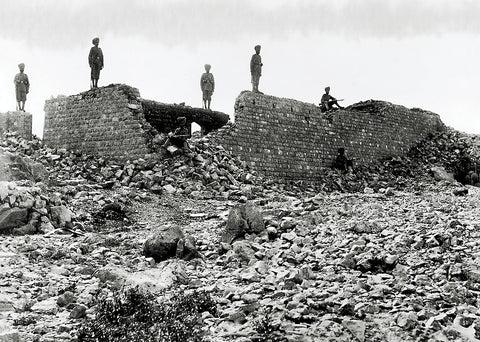
When 21 Sikh Soldiers Fought the Odds Against 10,000 Pashtun Warriors
Map showing
location of Saragarhi heliograph station.
From the dawn of human warfare to the present few areas of the world have been as highly contested as the mountainous region straddling the border of present-day India and Pakistan. In 1897 the region was known as the North-West Frontier Province of British India. On September 12 of that year, in what became known as the Battle of Saragarhi, 21 soldiers of the 36th (Sikh) Regiment of Bengal Infantry of the British Indian army fought a last stand against thousands of besieging Pashtun tribesmen. Theirs is a story of bravery in the face of overwhelming odds.
That year, in an effort to exert control over the traditionally volatile North-West Frontier, the British garrisoned a line of existing Sikh “forts”—really little more than makeshift mud-and-stone shelters. Among them were Fort Lockhart, atop the Samana Ridge, and Fort Gulistan, a few miles west in the Sulaiman Mountains. The two were not visible to one another. Midway between them was Saragarhi, a signal outpost that linked the forts using heliographs, tripod- mounted mirrors that directed reflected sunlight to communicate Morse code. The 36th Sikhs, which traced its origins to 1858, had been reformed at Jalan- dhar, Punjab, in 1887. In December 1896 the regiment was sent to the North- West Frontier, dispersed among the forts and tasked with quelling rebellious local Pashtuns. In early September 1897 Orakzai and Afridi tribesmen twice attacked Fort Gulistan. A relief column from Fort Lockhart helped repel both assaults.
On their return to Fort Lockhart the men of the relief column stopped at Saragarhi, raising the outpost’s strength to 21—three NCOs and 18 enlisted sepoys. On September 12 more than 10,000 tribal insurgents besieged Saragarhi while thousands more Pashtuns kept the forces at Forts Lockhart and Gulistan pinned in place, threatening to outflank any attempted sorties.
historynet magazines
Our 9 best-selling history titles feature in-depth storytelling and iconic imagery to engage and inform on the people, the wars, and the events that shaped America and the world.
For nearly seven hours the 21 Sikhs at Saragarhi, equipped only with small arms, repulsed incessant attacks. Recognizing the futility of their defense, they resolved to fight to the death and take as many of the enemy with them as they could. A record exists of their actions, as throughout the fight Sikh signaler Gurmukh Singh kept Lt. Col. John Haughton, the regimental commander at Fort Lockhart, apprised of what was happening via heliograph. Despite the peril, the sepoy kept on task, relating a blow-by-blow account of the battle while his fellow soldiers dropped in turn about him. At last came his final message: “They are getting in now. Shall I take a rifle, or shall I go on signaling?” Haughton granted Gurmukh Singh permission to defend himself. After carefully dismantling his signaling gear and packing it in its leather case, the sepoy picked up his rifle and alone continued the fight. Determined to flush the lone holdout, the Pashtuns set fire to the post. Gurmukh Singh is believed to have killed 20 of the enemy before succumbing to the flames. Two days later a relief column arrived at Saragarhi to find the bodies of the 21 fallen Sikhs. Scattered around them were upward of 400 enemy corpses.
When news of the battle reached London, members of Parliament gave a standing ovation to the fallen. All 21 Sikhs were posthumously awarded the Indian Order of Merit (equivalent to the Victoria Cross), the highest award of gallantry available to Indian soldiers at the time.
To honor those who fell at Saragarhi, the administrators of British India ultimately built two memorial gurdwaras—Sikh places of assembly and worship—in Punjab. To this day every September 12, on what has been designated Regimental Battle Honours Day, the Sikh Regiment of the Indian army honors the fallen 21 with ceremonies at the Saragarhi Memorial Gurdwara in Amritsar and the Gurdwara Saragarhi in Firozpur Cantonment, from which most of the regiment’s members hailed. While the territory remains hotly contested ground, the courage and sacrifice of the Saragarhi defenders has not been forgotten.
